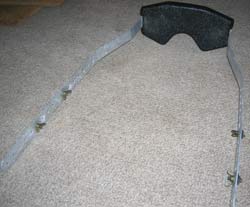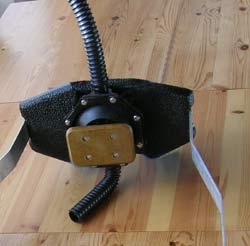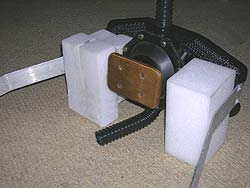Voetpomp in een PE-zeekajak

From a safety point of view a pump is a piece of equipment that should be aboard
of any seakayak.
Being convinced that a foot-operated pump is is the best option, I walk into
a problem regarding PE-seakayaks because it is difficult to mount a footpomp
there.
For a polyester kayak the mounting of a footpump is easy. Among other options it is a good solution to mount the pump on the bulkhead in the cockpit, giving the advantage of using the bulkhead as a footrest.
For a PE-seakayak however this is not a very good solution because PE seakayaks
are often equiped with foam bulkheads which are glued in place. Mounting a pump
on those will lead directly to leakage of the bulkheads once you are going to
apply quit a lot of force while paddling or pumping.
A more modern way of applying the bulkheads can be seen at the Valley-PE-seakayaks
for instance: these are welded in place. Although this is much stronger I do
not recommend to apply so much force to them during paddling and pumping. On
the longer term I expect damage or leakage of the bulkheads because a weld in
PE is not as strong as a polyester connection is.
Being a promotor of the footpump I have been thinking quite a lot about this problem.
Finally I found the solution when looking in my WW-kayak where a rigid construction, with a board as footrest, was installed. In my opnion it is easy to mount a footpump on a construction like that, which can be used in any seakayak: Thus also in PE-seakayaks.
|
The basic idea is this construction, which can be produced in several ways (just follow your creativity in this). The two metal bars are bolted to the kajak, making it possible to adjust it to other leg-lengths as well. The metal bars are quite long for 2 reasons:
|
 |
Basic steps:
|
 |
|
 |
| Remark: You could make the outlettube a little bit longer than necessary to make it possible to move the complete "pump&footrest device" a little bit for- or backwards. | |